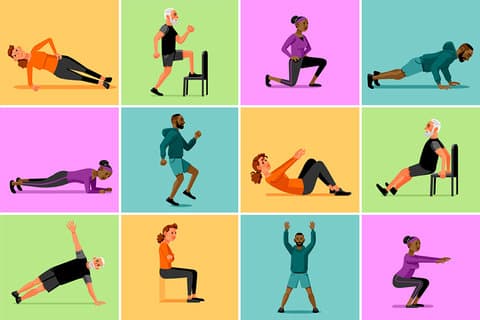The secret to better health – Exercise

The secret to better health — Exercise

Whether you’re 9 or 90, abundant evidence shows that exercise can enhance your health, body immunity and well-being. But for many people, sedentary pastimes, such as watching TV, surfing the Internet, or playing computer and video games, have replaced more physically active pursuits. In these days of social lockdown, it is imperative that we remain physically fit.
A well-rounded exercise program has four components: aerobic activity, strength training, flexibility training, and balance exercises. Each benefits your body in a different way.
Fighting disease with aerobic activity
Aerobic exercise is the centerpiece of any fitness program. Nearly all of the research regarding the disease-fighting benefits of exercise revolves around cardiovascular activity, which includes walking, jogging, swimming, and cycling. Experts recommend working out at moderate intensity when you perform the aerobic exercise — brisk walking that quickens your breathing is one example. This level of activity is safe for almost everyone and provides the desired health benefits. Additional health benefits may flow from the increased intensity.
Protecting bone with strength training
Strength or resistance training, such as elastic-band workouts and the use of weight machines or free weights, is important for building muscle and protecting bone.
Bones lose calcium and weaken with age, but strength training can help slow or sometimes even reverse this trend. Not only can strength training make you look and feel better, but it can also result in better performance of everyday activities, such as climbing stairs and carrying bundles. Stronger muscles also mean better mobility and balance, and thus a lower risk of falling and injuring yourself. In addition, more lean body mass aids in weight control because each pound of muscle burns more calories than its equivalent in fat.

Easing back pain with flexibility exercises
Stretching or flexibility training is the third prong of a balanced exercise program. Muscles tend to shorten and weaken with age. Shorter, stiffer muscle fibers make you vulnerable to injuries, back pain, and stress. But regularly performing exercises that isolate and stretch the elastic fibers surrounding your muscles and tendons can counteract this process. And stretching improves your posture and balance.
Preventing falls with balance exercises
Balance tends to erode over time, and regularly performing balance exercises is one of the best ways to protect against falls that lead to temporary or permanent disability. Balance exercises take only a few minutes and often fit easily into the warm-up portion of a workout. Many strength-training exercises also serve as balance exercises. Or balance-enhancing movements may simply be woven into other forms of exercise, such as tai chi, yoga, and Pilates.
Exercise at a glance
In a nutshell, exercise can:
- reduce your chances of getting heart disease. For those who already have heart disease, exercise reduces the chances of dying from it.
- lower your risk of developing hypertension and diabetes.
- reduce your risk for colon cancer and some other forms of cancer.
- improve your mood and mental functioning.
- keep your bones strong and joints healthy.
- help you maintain a healthy weight.
- help you maintain your independence well into your later years.


Leave a Reply
You must be logged in to post a comment.